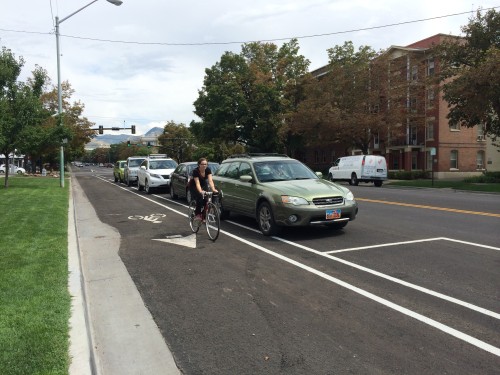
By Charles Pekow
Communities that install cycletracks are themselves heading in the right direction, as they are helping increasing numbers of people bike in the right direction. Lessons from the Green Lanes: Evaluating Protected Bike Lanes in the U.S. a new study of cycletracks, sometimes called green lanes or protected cycling facilities, done at the National Institute for Transportation & Communities in Portland, OR, indicates the lanes work as intended.
The researchers employed a variety of techniques, including watching and videotaping traffic on roads before and after cycletrack installation and surveying cyclists and the general public by mail. The project observed use of green lanes in five cities: Austin, TX; Chicago; Portland, OR; San Francisco; and Washington, D.C. The researchers watched 12,900 bicyclists over 144 hours of video and observed no accidents and a handful of close calls that required maneuvers like quick braking or a change in direction from either the driver or cyclist. (The research team says it didn’t collect enough data to determine safety, though.)
One lesson: the greater the buffer separating the cycling lane from auto traffic, the better, at least in people’s minds. In the survey, people said they felt better when some physical barrier (flexible posts, planters, curbs, or parking lanes) separated the two modes rather than just painting or striping the lane. Even though flexposts (bollards) don”t really provide physical protection, they helped get the message across to both cyclists an drivers who really belongs in the lanes, says the study.
In every city, the research showed that bicycle traffic increased on the roads with the new lanes a year after they were installed. Increases ranged from a significant 21 percent to a whopping 171 percent. Some cyclists said they changed streets; others said they started riding because they felt safer riding on the tracks. The study notes, however, that none of the cycletracks were more than a year old and it couldn’t judge long-term results. More research is needed in that area, the authors point out.
Each city used a different design at intersections where bicyclists had to share the road with cars and turn corners. Some employed “mixing zones” where autos and bicycles shared the pavement. Others directed cars to cross over the bike lane to make a turn. Both seemed to work well and not cause much confusion, but putting a through bike lane with a limited area for cars to turn seemed to work best. In Chicago, traffic lights were timed differently for autos and cyclists, which seemed to work.
While ridership of the lanes went up in all cases, the study notes that its figures don’t account for variations such as weather or schools being in session. Another factor that increased bike riding on some of the roads was that they were one-way streets that subsequently installed bike lanes in both directions.
A problem with protected lanes involves handling loading zones in business districts. The project included running a videotape by a hotel loading zone where trucks parked for making deliveries in Washington, DC. About a third of the delivery drivers didn’t park correctly and forced cyclists out of the bike lane.
The authors note that they didn’t study all possible designs and that more research is needed into other options and how different barriers affect use, perceptions and safety.
The study received funding from the U.S. Department of Transportation, People for Bikes (formerly Bikes Belong) and the Summit Foundation.
View the report at http://ppms.otrec.us/media/project_files/NITC-RR-583_ProtectedLanes_FinalReport.pdf.






